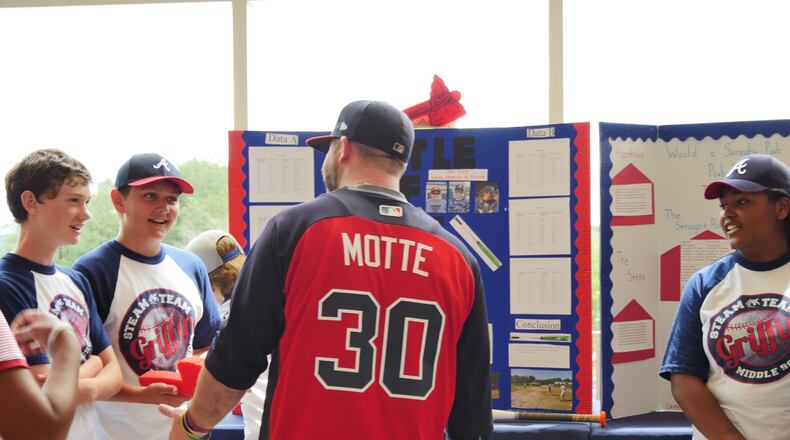While most of Cobb County was driving along I-75 and watching the building progress of the Braves’ new baseball stadium before it opened in April, students at area middle schools were studying the science of the sport, from how to calculate a strike zone to the composition of the soil on the pitcher’s mound.
On May 21, 10-student teams from eight Cobb middle schools presented their research projects to game-goers and a few Braves players as well at SunTrust Park. They were part of the Braves’ STEM Showcase that gave them a public forum to share their studies.
Their projects were part of the “Science of Sport” program the Cobb district adapted from the University of Arizona, said Sally Creel, the district’s STEM and innovation supervisor.
“When they showed us the idea last year, we decide to roll it out to eight schools this year,” she said. “Our program was funded through a partnership with the Braves and Comcast, and was a great way to have math, science and physical education teachers working together. In a STEM school, you’ll often see math and science teachers collaborating, but you don’t often see PE included. Anytime that happens, it’s awesome.”
The Science of Sport offers curriculum around a number of athletic endeavors, including soccer and football, but given that the Braves now call Cobb home, the district opted to concentrate on the science of baseball.
“The schools have gone crazy for it,” said Creel. “The kids love it. And at the same time, the curriculum aligns with our state standards in science, math and physical education.”
For instance, Creel said, students used baseball as the basis for figuring batting averages, measuring batting stances and strikes zone, and calculating the angles of bases.
“This program combined the science with the athleticism,” said Creel, “so kids who may not have been the best math or science students but understood the mechanics of baseball could work with students who understood the math and science part.”
The baseball theme permeated the schools, with some cafeterias serving Braves Burgers and Pop Fly chicken, and English classes writing a Braves song. “You name it, they were doing it,” said Creel. “The program created new opportunities to integrate baseball as the main theme throughout.”
Initially, Lisa Green, a teacher at Dickerson Middle in East Cobb, wasn’t sure how she’d work baseball into her sixth grade earth science course.
“The program had several lessons around math and physics, but I teach earth systems,” she said. “But I also love baseball, so I thought of all the weird things I’d heard about it over the years – such as the dirt is different on a baseball field. So I researched it and found yes, there are different compositions on different fields. And the pitchers’ mounds and batters’ boxes are 40 percent sand and 40 percent clay so they drain better.”
Green got the Braves to send three types of ballpark soil that her students could analyze.
“We had already studied the soil profile of the earth, so I figured we could apply the same inquiry to the soil on a baseball diamond,” said Green. “It was exciting to see the kids figure out what kind of soil worked best under the grass and on the warning track. It was a real-world application of what we’re studying, taking science out of the textbooks and putting it into their hands.”
Creel said that the district plans to expand the Science of Sport program into its remaining middle schools next year.
Information about the Science of Sport and other STEM initiatives in Cobb: stemcobb.com
Information about the Science of Sport and other STEM initiatives in Cobb: stemcobb.com.
About the Author
The Latest
Featured



